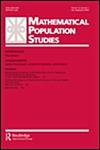系统抽样下使用分位数回归对总体均值的稳健估计
IF 1.3
3区 社会学
Q3 DEMOGRAPHY
引用次数: 2
摘要
研究变量的回归比均值估计量定义为给定辅助变量的普通最小二乘回归所提供的系数。它们可以通过使用的变异系数和峰度系数来改进。通过计算稳健回归系数来抵消异常值对总体平均值估计的影响,稳健回归系数通过最小绝对偏差、Huber-M、Huber-MM、Hampel-M、Tukey-M或调整后的最小二乘法获得。这些稳健系数用于估计简单随机抽样下的总体平均值。系统抽样是一种概率抽样,其中群体的每个元素都有相等的被包含概率,使用分位数回归提供的系数,其系数来自绝对偏差之和的最小化,而不是回归线的平方偏差人口平均数。这些估计量的均方误差用解析方法表示。如果分位数回归系数大于研究和辅助变量之间的协方差与辅助变量的方差之比减去和的平均值或变异系数、偏度或峰度的函数,则在系统抽样条件下,所提出的稳健分位数回归均值估计比存在异常值的比率估计更有效。原因是这些估计量只使用回归系数,而不是辅助变量的总体平均值和样本平均值之间的比率。上述情况发生在案例研究的值中。对于176个林带的经验数据,所提出的木材体积估计比基于分位数回归系数的比率估计有效30%以上。本文章由计算机程序翻译,如有差异,请以英文原文为准。
Robust estimation of the population mean using quantile regression under systematic sampling
ABSTRACT Regression ratio mean estimators of a study variable are defined as the coefficients provided by the ordinary least-squares regression of on a given auxiliary variable . They can be improved by using the coefficient of variation and the coefficient of kurtosis of . The influence of outliers on the estimates of the population mean of is neutralized by calculating robust regression coefficients, obtained by the method of either least absolute deviations, Huber-M, Huber-MM, Hampel-M, Tukey-M, or adjusted least squares. These robust coefficients are used to estimate the population mean of under simple random sampling. Extension to systematic sampling—which is a probability sampling in which every element of the population has equal probability of inclusion to be drawn—using the coefficients provided by quantile regression—whose coefficients result from the minimization of the sum of absolute deviations rather than from the square deviations from the regression line—requires ratio estimators of the population mean of . The mean square errors of these estimators are expressed analytically. If the quantile regression coefficient is greater than the ratio of the covariance between the study and the auxiliary variables to the variance of the auxiliary variable minus a function of the mean or the coefficient of variation, skewness, or kurtosis of and , then the proposed robust quantile regression mean estimator of is more efficient than the ratio estimators in the presence of outliers under systematic sampling. The reason is that these estimators only use regression coefficients and not the ratio between the population mean and sample means of the auxiliary variable . The aforementioned condition occurs with the values of the case study. For empirical data of 176 forest strips, the proposed estimate of the volume of timber is over 30% more efficient than the ratio estimates based on quantile regression coefficients.
求助全文
通过发布文献求助,成功后即可免费获取论文全文。
去求助
来源期刊

Mathematical Population Studies
数学-数学跨学科应用
CiteScore
3.20
自引率
11.10%
发文量
7
审稿时长
>12 weeks
期刊介绍:
Mathematical Population Studies publishes carefully selected research papers in the mathematical and statistical study of populations. The journal is strongly interdisciplinary and invites contributions by mathematicians, demographers, (bio)statisticians, sociologists, economists, biologists, epidemiologists, actuaries, geographers, and others who are interested in the mathematical formulation of population-related questions.
The scope covers both theoretical and empirical work. Manuscripts should be sent to Manuscript central for review. The editor-in-chief has final say on the suitability for publication.
 求助内容:
求助内容: 应助结果提醒方式:
应助结果提醒方式:


